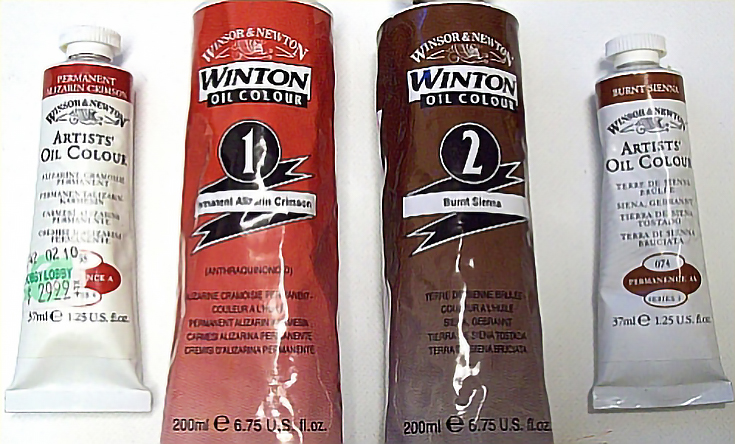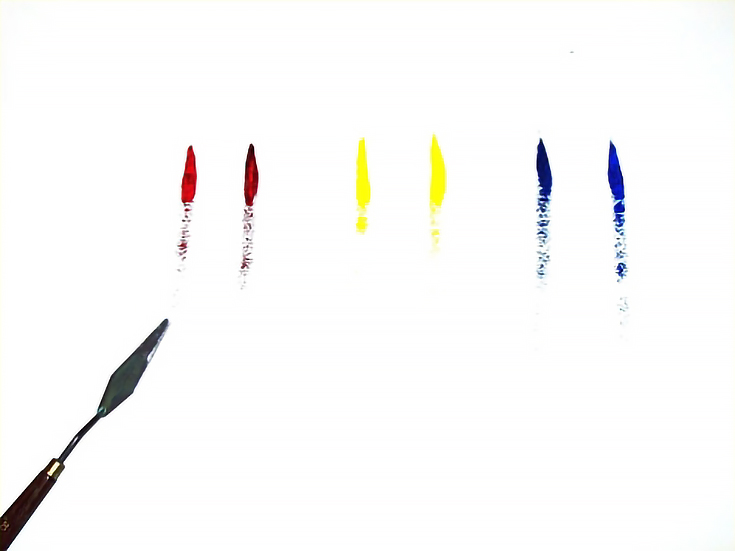Most oil painters know that they can get a 200ml tube of good quality “student grade” oil paint for $10-$15. But there are also higher quality “professional grade” oil paints (in comparatively tiny tubes of 37ml or so) which will set you back almost twice as much.
So the question is, other than price, what’s the difference?
One brand that makes both professional and student grade oil paints is Winsor & Newton. In order to get a good sense of how their student grade colors compare to their professional grade versions, let’s examine three important colors up close.
Student Grade (Winton):
1. Permanent Alizarin Crimson
2. Cadmium Yellow Pale Hue
3. Cobalt Blue Hue
Professional Grade (Artists’ Oil Colours):
1. Permanent Alizarin Crimson
2. Cadmium Yellow Pale
3. Cobalt Blue
Since the ingredients and other important properties are noted right there on each tube, we might as well begin our comparisons by reading the label.
Ratings
Each of the colors above have been given a “1” rating for Lightfastness, which is the highest possible rating. In that, at least, both artist grade and student grade are equal.
In addition, all of these colors except the professional grade Cobalt Blue received an “A” rating for Permanence.
The Cobalt Blue is rated “AA” which is considered “Extremely Permanent.” (I should mention that several other student grade colors which are not included in this article are rated “AA” as well.)
Ingredients
All of the student grade colors use Linseed Oil. The professional grade colors use Linseed Oil and/or Safflower Oil as the vehicle for their pigment.
Pigments (this is where it gets tricky)
1. Both the student grade and the professional grade Permanent Alizarin Crimson utilize synthetic Alizarin, called Anthraquinone PR177.
As it turns out, the synthetic is better than the original, since it’s a more Permanent color. (For more information on permanence and pigments, you may want to check out Winsor & Newton’s Composition & Permanence Tables.)
2. The other student grade colors, Cadmium Yellow Pale Hue and Cobalt Blue Hue, use a different and less expensive pigment than their professional grade versions.
So all of these paints are rated very durable. They use similar oils for their medium. The only difference is that some of them use differently priced pigments. But how do these different pigments compare on the canvas?
The color test
I’ve applied small dabs (approx. 0.02ml each) of each the colors listed above to the canvas. Student grade oils are on the left, professional grade oils are on the right.
Now watch what happened when I used a palette knife to spread the paint. Right away, some interesting properties have been revealed:
The professional grade crimson appears darker than its student grade counterpart, as is somewhat the case with the professional grade Yellow, although the camera is blown away by the strength of both yellows, rendering them nearly identical.
The professional grade Cobalt Blue, on the other hand, comes across lighter than the student grade version.
Now take a look at what happened when I dipped my brush into some Liquin and mixed the paint with the medium, right there on the canvas:
Almost instantly both the Crimson and Yellow reveal two things.
First, the difference in hue disappears. And second, the professional grade stretches about twice as far, indicating that it contains more pigment.
The Cobalt Blue proves to be the odd one out, since the pigment-load appears about the same but the hues do not match.
So what’s the takeaway?
Looking at the the results of this experiment may help you decide if and when to spend more on professional grade paint. Remember, you can mix and match. Also, your approach to oil painting may be a factor to consider.
For example, how large do you paint? (In other words, do you use a lot of paint?)
Also, do you primarily care about how good your painting looks and how long it will last, or do you also want your customers to know that you’re using only the most exquisite pigments?
And of course, is money an issue? A small tube of the professional grade paint is about the same price as two 200ml tubes of student grade paint. That’s 10 times the cost, for maybe twice the pigment strength!
Then again, it’s not all about common sense. After all, it’s art! If you want a little decadence, or simply prefer a higher pigment count, then professional grade oil colors are probably the choice for you.
But if you just can’t afford them, there’s no shame. Based on this experiment, I’d have to say, “Who will really be able to tell the difference?”
This post may contain affiliate links.




